A strong motivator for starting this blog was my recent semi-impulse purchase of my first ever devoted running watch. Last week on one of my lunch breaks I wandered into the Running Room at the corner of Georgia and Burrard in Vancouver’s west end. I was looking at the running watch display and got to talking with one of the sales reps. I got some good information about the Garmin ForeRunner 220, but the woman behind the counter kept eluding to a better, more mysterious watch. The big brother of the 220. The Garmin ForeRunner 620.
I left the store with new hand-held bottles for myself and my girlfriend Marianne (it is easier than having to buy myself another one after she steals it) and, after work, got into doing some research. The FR620 is not a cheap watch. It retails in Canada for $499.95 so I wanted to understand what it had to offer. It turns out, it has a lot. In addition to the standard stopwatch and heart rate monitor, the FR620 is a GPS watch so it allows tracking of distance, pace, elevation change and a host of other cool geographic features. It also measures VO2 Max (how effectively your body is using oxygen), cadence (steps per minute), and vertical oscillation (how high you bounce with each stride). After comparing it with other GPS watches on the market as well as to the significantly cheaper FR220, I decided to bite the bullet and drain my bank account. I did just get my tax return. That is found money… right?
I’ve had the watch for 4 days now and I’ve only just begun to play with it, but I thought I would at least share my first impressions.
Appearance/Hardware
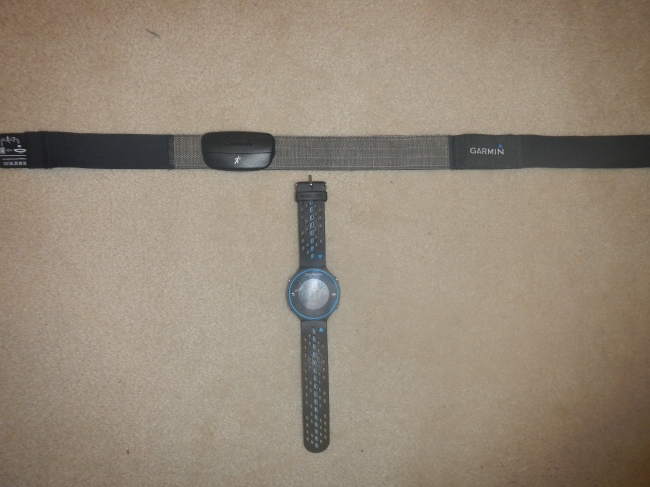
Out of the box you basically get 4 things: the watch itself, the heart rate monitor/band, the USB dock for hooking it up to your computer, and the quick start guide. I read enough reviews and watched enough videos before buying it to make the start up guide mostly useless, leaving me with the fun stuff.
The watch itself is impressively normal in size and shape. The reason I have waited so long to get a proper running watch (I have been running pretty consistently for 3 years) is that the ones I knew about were always big and bulky and generally not something you want on your wrist through a sweaty 10K. The 620 defies what I thought was possible for a wrist-mounted GPS unit. The diameter of the face is 1.8 inches (4.5 cm) and the thickness is only half an inch (1.25 cm). Compared with my outdoor watch (Suunto Vector) the 620 is light and sleek. The 220 has exactly the same dimensions but differs from the 620 in one very cool way. The 620 has a touchscreen, limiting the need for physical buttons to 4 instead of 5. The buttons (from top left moving clockwise) are for the backlight, starting/stopping/pausing a run, uploading workouts, and going back to the clock. The band itself is made of rubber and lined with holes to improve breathability and limit weight. In short, it feels good on my wrist. However, I am used to my much larger outdoor watch so if you are new to the whole multi-function watch racket, it might take some getting used to.
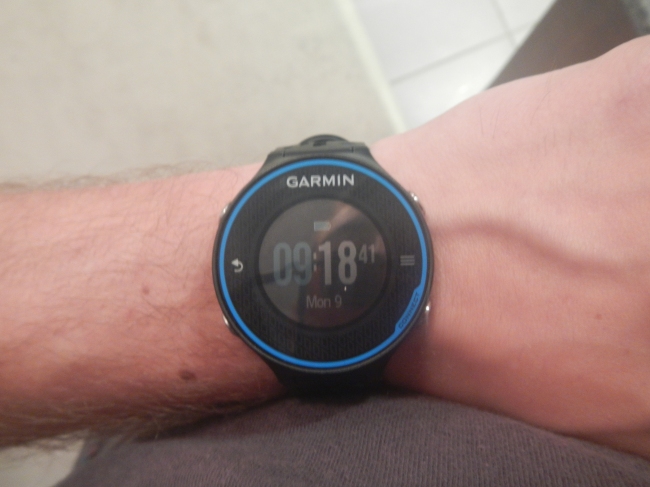
The heart rate monitor is also impressively subtle. I was hesitant about wearing something around my chest while running but having done a trail run and a hike this weekend and having forgotten to take of the chest monitor before driving home from the mountains, I can attest to the fact that it is comfortable and nonrestrictive.
The USB dock does its job, it’s small and easy to use. My one beef with it is that whereas the 220 comes with a dock that all but locks the watch in place, the 620’s dock is smaller and holds the watch only with magnets. One reviewer for the 220 gushed that he could swing the watch in the dock around his head by the USB cable and not have the watch come out, so I’m not sure why they changed it up for the more expensive version. It’s a small concern, though. I barely ever have the watched hooked up to the computer except to charge the battery, which lasts around 10 hours with GPS enabled and 6 week in stand-by (clock mode). The 620 also includes a wireless upload feature that lets you sync your workouts to the Garmin software with the touch of a button on the watch itself, so you don’t have to worry about pluggin it in or having it fall out of the dock mid-upload.
Ease of Use
It’s hard to say if the interface would be intuitive for someone with no background information on the watch, but given that this thing costs a significant chunk of money and given that most consumers will do some online research before making a purchase of this size, most people probably have some idea how to work the watch before they ever buy it. I was no exception. Reviews and videos like this amazingly in-depth one make the menus seem pretty intuitive. It is also nice having the touch screen so you can flip through things quickly and easily.
When I booted up the watch for the first time it asked me more my age, height, and weight as well has my preferred measurement units (metric v. the other nonsensical kind). When in stand-by it serves the purpose of a watch well, displaying date, time, battery life and all that jazz. When in running mode it locks on to satellites without me doing anything and it does it shockingly quickly. In the heart of downtown it took a minute or two the first time and at the trailhead on Saturday it took less than 5 seconds. I’m impressed so far. The date and time are also synced with satellites so you don’t have to change any settings in that respect. Plus you get to tell everyone what time it is in space.
Running
This weekend, one of my best friends (Arun) was in town visiting so the two of us put the 620 through its paces by running the Two Canyon Loop in North Vancouver, one of my favourite trails. Running with someone else is always a little tricky. They can be faster over one section of the trail while you are quicker on another. When they don’t know the route there are obvious pace allowances for unexpected gravel and whatnot. I was also playing tour-guide on the run, showing Arun waterfalls, cliffs, and suspension bridges. In short, it was far from a full-on, focused workout. Even still, the watch was super simple to use and recorded data reliably even though we were in heavy tree cover.
The one annoying thing I noticed was that the Auto Pause feature was a little out of whack. It left the watch running while we were stopped in a few places and paused the watch seemingly randomly in a few places. I turned it off halfway through the run and found the manual start/stop to be much easier and more reliable. Outside of that, the watch worked like a dream. The output on the Garmin software showing the map of our route and graphs for heart rate, cadence, elevation, and a million other things are clear, and fun to play with. That being said, I haven’t had a chance to dive into things really in depth yet; but at first glance I am blown away with the amount of data I got and how little I had to do to get it.
I will cut myself off there but feel free to meander through the pictures below recapping the run and summarizing some of the data. In closing, I am very happy with the watch so far. I plan to dig into the various features in future posts and I will update my reported fitness level when I have more data points. So, to paraphrase John Travolta, I don’t know if the watch is worth $500 bucks, but so far it’s pretty friggin’ good.
Cheers,
Steve

Showing a grateful friend a good time in the North Shore mountains.

Shot of the trail with Arun in view. The boardwalk is a short reprieve from the gravel/roots.
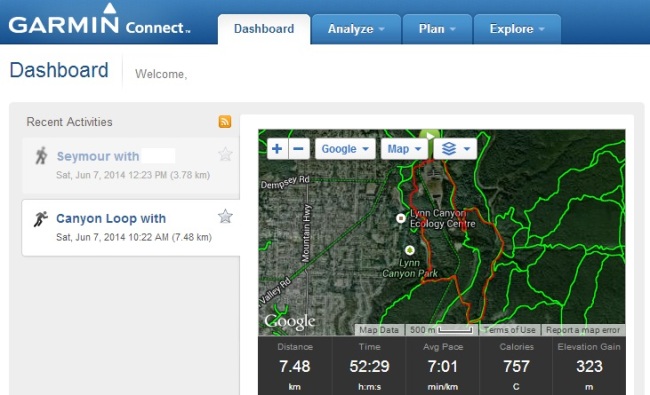
Garmin Connect Dashboard. The first thing I saw after signing in.
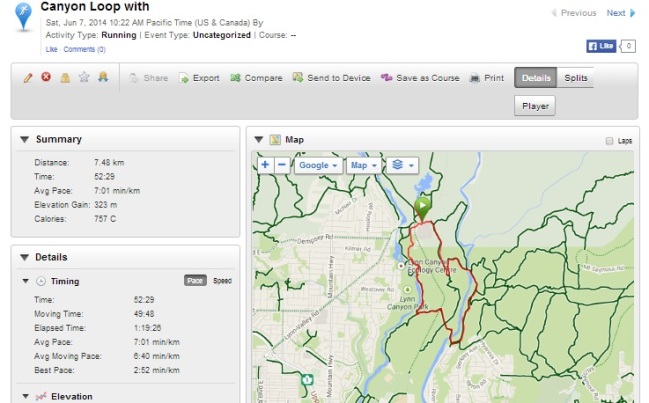
An activity page for my Saturday run. The page also includes weather and device data (not shown)
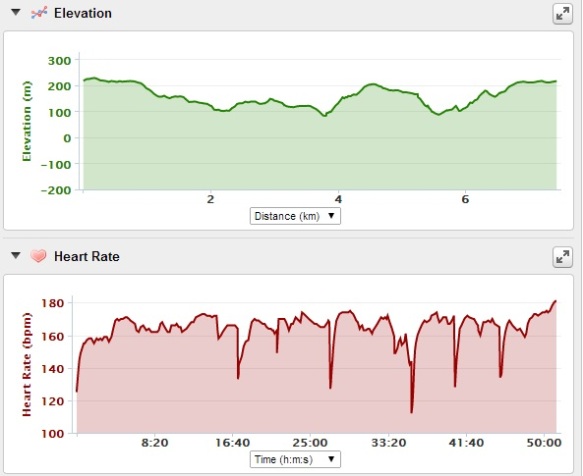
Elevation and Heart Rate graphs. The many valleys on the HR graph denote points of interest on the tour I was giving.
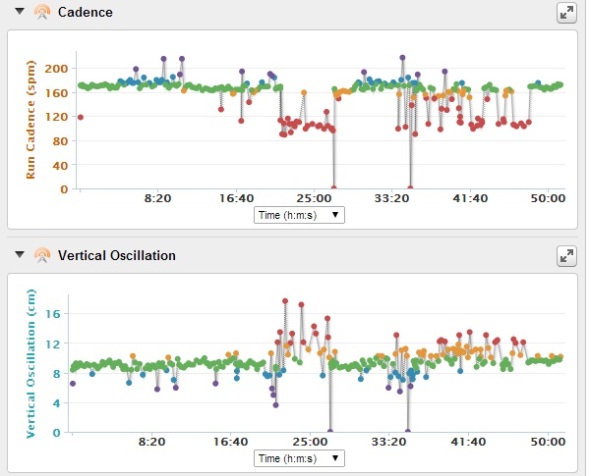
Cadence and Vertical Oscillation. Measured using an accelerometer in the heart monitor. Data points are colour coded red (below average), yellow (average), green (good), and purple (excellent). Not making excuses for all the red points, but this trail has a lot of steep climbs and I was showing off cool sites along the way.
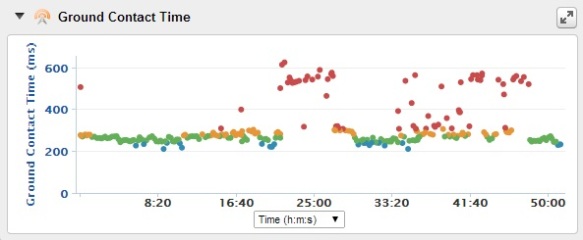
Ground contact time.













